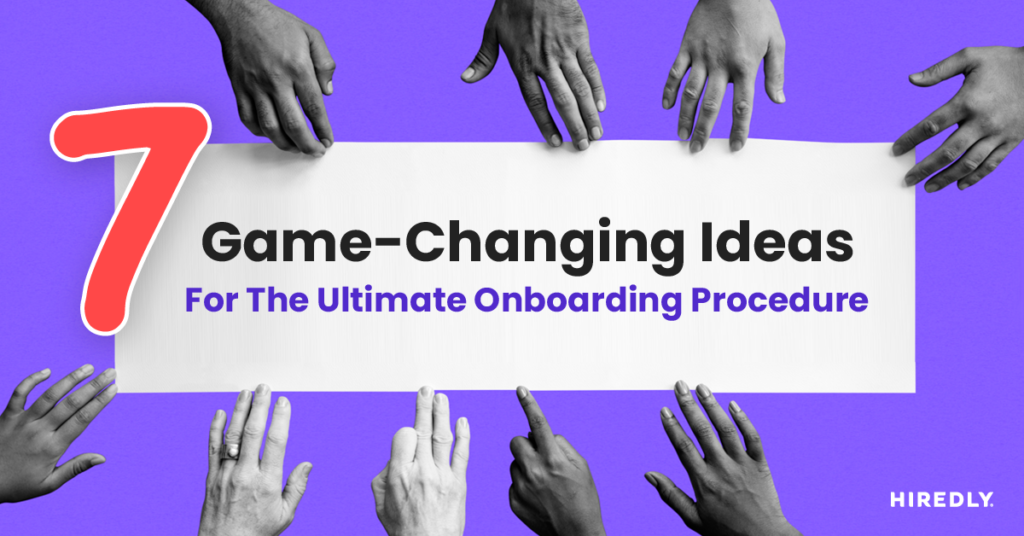Why is onboarding important?
Onboarding is the first experience your new hire will have at the company. A solid onboarding experience will warm them up to your company culture, working styles and expectations.
Did you know that only 32% of companies have a formal onboarding process? If you’re part of the 68% that avoid onboarding altogether, you might be missing out on better employee retention.
A study has shown that 69% of employees who experienced an excellent onboarding process will stay with a company for 3 years. 58% say they will stay even after the 3 years with a structured onboarding process.
And if not for the longevity of the hires, your onboarding can boost the productivity of new employees by a whopping 50%! Now that’s how you know you’re starting things on the right foot.
7 Ideas for the Ultimate Onboarding Experience
1. Start by Telling Your Company’s Story

Before planning the structure of your onboarding, put yourself in your new hires’ shoes and imagine what they’d like to experience. Like a story arc, visualize the beginning, the climax, and the ending.
It’s easy to want to dive straight into the nitty-gritty details of their role. But it’s worth investing time into telling your company’s story in the early stages of the onboarding process. Stories are memorable and captivating when done right.
Share who you are, what you do, what you stand for and why your work matters. Hone in on your company’s values and culture and paint a picture of the new hire’s future at the company.
The goal is to get them excited to be a part of the journey and emphasize the value of their work.
Related read: Employer Branding In Malaysia: What It Is And How To Identify Yours
2. Simulate Your Customer Experience

You’ve put a lot of attention and care into giving your clients and customers the best experience. So why should your employee orientation be any different?
The orientation experience should reflect the nature of your business. If your company is known for high-end customer experience, the onboarding process should have the same feel.
It’s not just about entertaining your new employees.
What the new hires experience during their onboarding process will set the tone for their entire career at your company. It also gives them a glimpse of how they are expected to perform later on.
3. Introduce Important Names and Faces

We’ve all been there. When you’re in a completely new place, everything from the office to new faces can feel disorienting at first. A good onboarding will help them warm up to the new environment.
Don’t forget to slot in a time to introduce new employees to key members of the company. You can also take this time to explain how the different departments work together.
Give them access to organisation charts with roles and photos via email or a shared drive to refer to on their own time.
4. Be Transparent with Expectations
Setting the right expectations with your recruits can clear up any potential misunderstandings down the road.
Inform them of any specific expectations, goals or targets they need to achieve, and the time frame they need to achieve them.
This exercise will give them a clearer picture of what to do next and nurture them into the right direction.
5. Build an Onboarding Roadmap
Don’t treat your onboarding like a one-off event. Take it from Miro, the visual collaboration whiteboard company.
Inspired by Michael Watkins’ book ‘The First 90 Days’ (a book about taking charge during critical transition periods), Miro’s onboarding experience covers the first 90 days.
Here’s an inside look at their 30, 60, and 90-day plans:
- Day 1 – 30: Hands-on introduction to tools and projects.
- Day 31 – 60: Assign new hires responsibilities and encourage collaboration with their team.
- Day 61 – 90: Encourage independence in their assigned roles with limited guidance.
Read more about building a 90-day onboarding plan here.
6. Introduce a Buddy System

When the social media management platform, Buffer, decided to do away with its 45-day bootcamp, it had to rethink its entire onboarding process.
One of their new efforts included opting for a buddy system. This system was implemented to communicate the company culture and processes in a unified way.
Thinking of doing the same? The buddy system is an excellent way to get your existing employees involved. It also allows new hires to make connections within the company from their very first day.
Here’s how Buffer’s onboarding buddy system works:
- Buddy #1 (Hiring Manager): Usually the new hire’s direct supervisor, the hiring manager coordinates the onboarding process. They also work closely with the assigned buddies for feedback and corrections.
- Buddy #2 (Role Buddy): A peer working on the same team who helps the new hire ease into their new role.
- Buddy #3 (Culture Buddy): Someone from a different team who helps the new employee with work culture, company history or norms.
Of course, you don’t have to apply Buffer’s buddy system to a tee. Instead, take inspiration and customize a buddy system that works for your company!
Related read: The Evolution of Onboarding at Buffer: How We Welcome New Teammates
7. Mix Things Up

Mixing up your method of onboarding can inject variety and fun into the process. Try experimenting with different media such as pre-recorded videos.
A few videos you can produce beforehand are:
- Welcome message from your CEO
- An introductory video to your company history and/or culture
- Product training or demonstrations
It may take some time and effort to set up in the beginning, but pre-made videos can help align your messaging and ease your job in the long run.
Need help with company videos?
Our team at Hiredly Studios can help produce your videos from content ideas, and filming to editing. Contact us at [email protected] for more info!

Videos make excellent additions to your onboarding but don’t fall into the trap of automating everything either! You wouldn’t want to lose the human touch. It is the key to establishing genuine connections with your new employees.
Add more variety with ice breakers between onboarding activities. It keeps things engaging while reducing the stress that comes with information overload.

